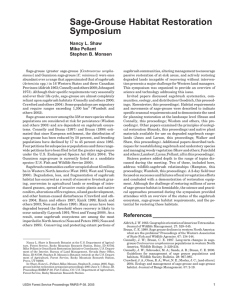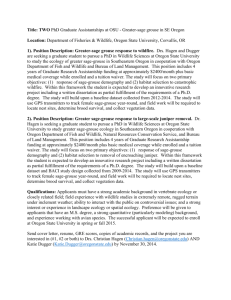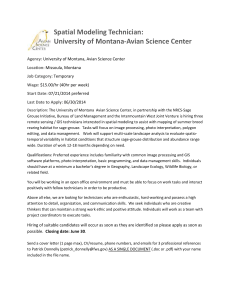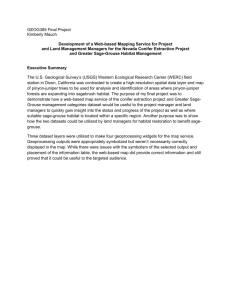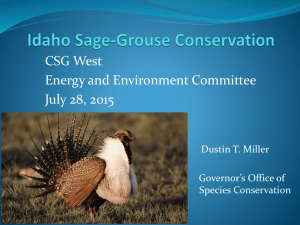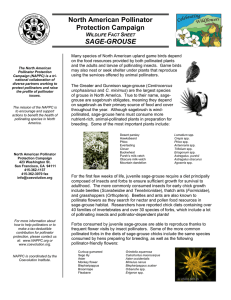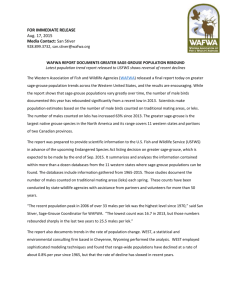Multi-Species Benefits of the Proposed North American Sage-Grouse Management Plan Abstract
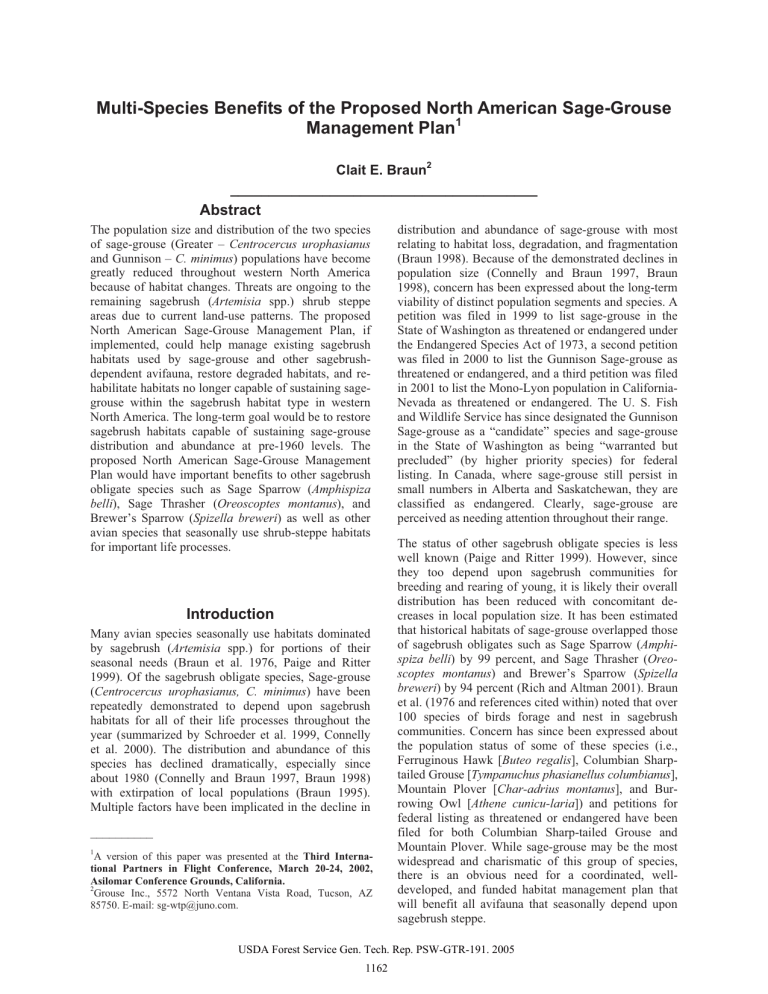
Multi-Species Benefits of the Proposed North American Sage-Grouse
Management Plan
1
Clait E. Braun
2
________________________________________
Abstract
The population size and distribution of the two species of sage-grouse (Greater – Centrocercus urophasianus and Gunnison – C. minimus ) populations have become greatly reduced throughout western North America because of habitat changes. Threats are ongoing to the remaining sagebrush ( Artemisia spp.) shrub steppe areas due to current land-use patterns. The proposed
North American Sage-Grouse Management Plan, if implemented, could help manage existing sagebrush habitats used by sage-grouse and other sagebrushdependent avifauna, restore degraded habitats, and rehabilitate habitats no longer capable of sustaining sagegrouse within the sagebrush habitat type in western
North America. The long-term goal would be to restore sagebrush habitats capable of sustaining sage-grouse distribution and abundance at pre-1960 levels. The proposed North American Sage-Grouse Management
Plan would have important benefits to other sagebrush obligate species such as Sage Sparrow ( Amphispiza belli ), Sage Thrasher ( Oreoscoptes montanus ), and
Brewer’s Sparrow ( Spizella breweri ) as well as other avian species that seasonally use shrub-steppe habitats for important life processes. distribution and abundance of sage-grouse with most relating to habitat loss, degradation, and fragmentation
(Braun 1998). Because of the demonstrated declines in population size (Connelly and Braun 1997, Braun
1998), concern has been expressed about the long-term viability of distinct population segments and species. A petition was filed in 1999 to list sage-grouse in the
State of Washington as threatened or endangered under the Endangered Species Act of 1973, a second petition was filed in 2000 to list the Gunnison Sage-grouse as threatened or endangered, and a third petition was filed in 2001 to list the Mono-Lyon population in California-
Nevada as threatened or endangered. The U. S. Fish and Wildlife Service has since designated the Gunnison
Sage-grouse as a “candidate” species and sage-grouse in the State of Washington as being “warranted but precluded” (by higher priority species) for federal listing. In Canada, where sage-grouse still persist in small numbers in Alberta and Saskatchewan, they are classified as endangered. Clearly, sage-grouse are perceived as needing attention throughout their range.
Introduction
Many avian species seasonally use habitats dominated by sagebrush ( Artemisia spp.) for portions of their seasonal needs (Braun et al. 1976, Paige and Ritter
1999). Of the sagebrush obligate species, Sage-grouse
( Centrocercus urophasianus, C. minimus ) have been repeatedly demonstrated to depend upon sagebrush habitats for all of their life processes throughout the year (summarized by Schroeder et al. 1999, Connelly et al. 2000). The distribution and abundance of this species has declined dramatically, especially since about 1980 (Connelly and Braun 1997, Braun 1998) with extirpation of local populations (Braun 1995).
Multiple factors have been implicated in the decline in
__________
1 A version of this paper was presented at the Third International Partners in Flight Conference, March 20-24, 2002,
2
Asilomar Conference Grounds, California.
Grouse Inc., 5572 North Ventana Vista Road, Tucson, AZ
85750. E-mail: sg-wtp@juno.com.
The status of other sagebrush obligate species is less well known (Paige and Ritter 1999). However, since they too depend upon sagebrush communities for breeding and rearing of young, it is likely their overall distribution has been reduced with concomitant decreases in local population size. It has been estimated that historical habitats of sage-grouse overlapped those of sagebrush obligates such as Sage Sparrow ( Amphispiza belli ) by 99 percent, and Sage Thrasher ( Oreoscoptes montanus ) and Brewer’s Sparrow ( Spizella breweri ) by 94 percent (Rich and Altman 2001). Braun et al. (1976 and references cited within) noted that over
100 species of birds forage and nest in sagebrush communities. Concern has since been expressed about the population status of some of these species (i.e.,
Ferruginous Hawk [ Buteo regalis ], Columbian Sharptailed Grouse [ Tympanuchus phasianellus columbianus ],
Mountain Plover [ Char-adrius montanus ], and Burrowing Owl [ Athene cunicu-laria ]) and petitions for federal listing as threatened or endangered have been filed for both Columbian Sharp-tailed Grouse and
Mountain Plover. While sage-grouse may be the most widespread and charismatic of this group of species, there is an obvious need for a coordinated, welldeveloped, and funded habitat management plan that will benefit all avifauna that seasonally depend upon sagebrush steppe.
USDA Forest Service Gen Tech Rep PSW-GTR-191 2004
USDA Forest Service Gen. Tech. Rep. PSW-GTR-191. 2005
1162
Sage-Grouse Management Plan Multi-Species Benefits - Braun
Proposed North American Sage-
Grouse Management Plan
There is a need for a basic policy document to benefit sage-grouse (as well as other sagebrush-dependent species) that can be supported by individuals and public and private agencies across the International boundary with Canada in western North America. The goals of such a plan would be to: 1) enhance sage-grouse distribution and abundance through management of sagebrush-steppe habitats, and 2) restore sage-grouse distribution and abundance to pre 1960 levels within 25 years. Initial objectives would be to:
1.
Develop an International framework (committee) to guide overall efforts for maintaining, restoring, and rehabilitating sagebrush-steppe habitats so that sage-grouse populations can increase.
2.
Identify priority regional sagebrush-steppe habitat areas irrespective of political boundaries encompassing most present sage-grouse populations.
3.
Develop International-funding mechanisms between Federal (Canadian Wildlife Service, U.S.
Fish and Wildlife Service) and State and Provincial wildlife agencies as well as public land management agencies (Bureau of Land Management, U. S. Forest Service, U. S. National Park
Service, etc.) on a proportional basis.
4.
Develop and implement regional conservation plans (Joint Initiatives) using feasible conservation strategies to enhance sage-grouse habitats and populations.
5.
Measure sage-grouse population response to habitat treatments.
6.
Serve as a catalyst for major joint, coordinated activities by Federal and State/Provincial agencies.
The proposed North American Sage-Grouse Management Plan has been patterned after the highly successful North American Waterfowl Management Plan as described by Clarke (1987) and Patterson and Nelson
(1988). However, no funding has been identified for the proposed North American Sage-Grouse Management Plan, other than a suggested proportional division of costs, and organization of the International committee has not been established. Further no commitments by any Federal or State/Provincial wildlife agency have been made to the concept of such a plan for sagegrouse. Some State and Provincial wildlife agencies historically have been reluctant to work cooperatively with Federal agencies and, at times, with adjacent
States and or Provinces to manage “resident” bird species. Sage-grouse are not classified as “migratory” birds even though populations are known to move between states (i.e., Colorado into Utah and Wyoming,
Idaho into Montana, Oregon into Nevada, etc.). The proposed North American Sage-Grouse Management
Plan also differs in that a 25-year schedule is suggested
(instead of the initial 15-year horizon suggested by
Patterson and Nelson [1988] for the North American
Waterfowl Plan). Twenty-five years appears more realistic given the slow response expected from habitat treatments in the sagebrush steppe.
Multi-Species Benefits
Maintaining existing occupied habitats, restoring degraded habitats, and rehabilitating former shrub-steppe habitats should benefit sage-grouse and all other sagebrush avian obligate species as well as other species known to use sagebrush habitats. Increases in distribution and abundance can be expected for sage-grouse,
Sage Sparrows, Sage Thrashers, and Brewer’s Sparrows as well as some other species that nest and rear young in sagebrush-dominated habitats. However, species such as Horned Lark ( Eremophila alpestris ) and
Western Meadowlark ( Sturnella neglecta ) that have benefited from establishment of monocultures of exotic grasses may decrease. Enlightened management of shrub-steppe habitats should lead to improved management of riparian areas and other wet sites (ponds, springs, seeps). Management of these sites has the potential to benefit many other avian species.
The goals of the proposed North American Sagegrouse Management Plan are intended to benefit sagegrouse. However, sage-grouse can be viewed as
“umbrella” species (Rich and Altman 2001) as they are charismatic because of their elaborate breeding displays which are familiar to many people in North
America. Ensuring the health of habitats useful to maintaining and enhancing sage-grouse populations should also ensure the health of many other sagebrushdependent species.
Acknowledgments
A proposed North American Sage-grouse Management
Plan has been informally discussed with many biologists and managers involved with sage-grouse and sagebrush habitats. While the plan has not been popular with some, most individuals and agencies agree that uniform, coordinated approaches are needed not only within States and Provinces but also throughout specific regionally important areas for sage-grouse. I thank all who have listened and offered comments. Preparation
USDA Forest Service Gen Tech Rep PSW-GTR-191 2004
USDA Forest Service Gen. Tech. Rep. PSW-GTR-191. 2005
1163
Sage-Grouse Management Plan Multi-Species Benefits - Braun of this paper was encouraged by D. Mehlman of The
Nature Conservancy. This is a contribution from
Grouse Inc.
Literature Cited
Braun, C. E. 1995. Distribution and status of Sage Grouse in
Colorado.
Prairie Naturalist 27: 1-9.
Braun, C. E. 1998. Sage Grouse declines in western North
America: what are the problems?
In: Proceedings of the
Western Association of State Fish and Wildlife Agencies, volume 78; 139-156.
Braun, C. E., M. F. Baker, R. L. Eng, J. S. Gashwiler, and M. H.
Schroeder. 1976. Conservation committee report on effects of alteration of sagebrush communities on the associated avifauna.
Wilson Bulletin 88: 165-171.
Clarke, H. A. 1987. Recent accomplishments and future challenges in wildlife conservation and management.
Transactions of the North American Wildlife and Natural
Resources Conference 52: 32-37.
Connelly J. W., and C. E. Braun. 1997. Long-term changes in
Sage Grouse Centrocercus urophasianus populations in western North America.
Wildlife Biology 3: 229-234.
Connelly, J. W., M. A. Schroeder, A. R. Sands, and C. E. Braun.
2000.
Guidelines to manage Sage Grouse populations and their habitats.
Wildlife Society Bulletin 28: 967-985.
Paige, C., and S. A. Ritter. 1999. Birds in a sagebrush sea:
Managing sagebrush habitats for bird communities.
Boise, ID: Partners in Flight Western Working Group.
Patterson, J. H. and H. K. Nelson. 1988. Progress in implementing the North American Waterfowl Management
Plan.
Transactions of the North American Wildlife and
Natural Resources Conference 53: 24-28.
Rich, T., and B. Altman. 2001. Under the Sage Grouse umbrella.
Bird Conservation 14: 10.
Schroeder, M. A., J. R. Young, and C. E. Braun. 1999. Sage
Grouse ( Centrocercus urophasianus ).
In: A. Poole and F.
Gill, editors. The Birds of North America, No. 425.
Philadelphia, PA: The Birds of North America, Inc.
USDA Forest Service Gen Tech Rep PSW-GTR-191 2004
USDA Forest Service Gen. Tech. Rep. PSW-GTR-191. 2005
1164

